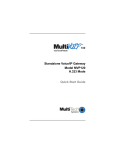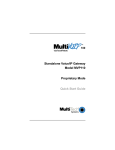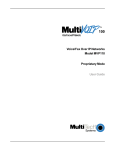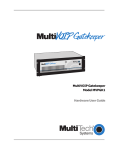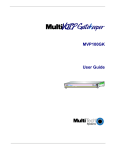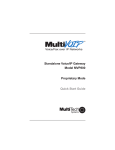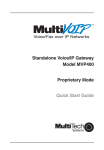Download Standalone Voice/IP Gateway Model MVP110 H
Transcript
Voice/FaxoverIPNetworks 100 Standalone Voice/IP Gateway Model MVP110 H.323 Mode Quick Start Guide Quick Start Guide 82050950 Revision A MultiVOIP 100 (Model MVP110) This publication may not be reproduced, in whole or in part, without prior expressed written permission from Multi-Tech Systems, Inc. All rights reserved. Copyright © 2001, by Multi-Tech Systems, Inc. Multi-Tech Systems, Inc. makes no representations or warranties with respect to the contents hereof and specifically disclaims any implied warranties of merchantability or fitness for any particular purpose. Furthermore, Multi-Tech Systems, Inc. reserves the right to revise this publication and to make changes from time to time in the content hereof without obligation of Multi-Tech Systems, Inc. to notify any person or organization of such revisions or changes. Record of Revisions Revision Description A Initial Release. (06/06/01) Patents This Product is covered by one or more of the following U.S. Patent Numbers: 5.682.386; 5.757.801; 6.151.333. Other Patents Pending. TRADEMARK Trademark of Multi-Tech Systems, Inc. is the Multi-Tech logo. Windows and Netmeeting are registered trademarks of Microsoft. Multi-Tech Systems, Inc. 2205 Woodale Drive Mounds View, Minnesota 55112 (763) 785-3500 or (800) 328-9717 U.S. Fax 763-785-9874 Technical Support (800) 972-2439 http://www.multitech.com Contents Introduction ................................................................................... 4 Related Documentation ................................................................. 5 Installing Your MVP110 ................................................................. 6 Installing and Configuring Your MVP110 ................................. 6 Deploying the VOIP Network .................................................. 7 Unpacking Your MultiVOIP ............................................................ 8 Safety Warnings ............................................................................ 8 Cabling Your MultiVOIP ................................................................. 9 Cabling Procedure .................................................................. 9 Installing Your MVP110 Software ................................................. 11 Configuring Your MultiVOIP ......................................................... 15 Registering with a Gatekeeper Phone Directory ................... 23 Building a Proprietary Phonebook Directory ......................... 27 Configuring Your Slave MVP110s ......................................... 35 Deploying the VOIP Network ....................................................... 45 Remote Site Administrator .................................................... 45 Limited Warranty ......................................................................... 47 Technical Support ........................................................................ 48 FCC Declaration .......................................................................... 49 iii MultiVOIP Quick Start Guide Introduction Welcome to Multi-Tech's stand-alone Voice/IP Gateway, the MultiVOIP model MVP110. The MVP110 allows analog voice and fax communication over an IP network. Multi-Tech’s voice/ fax gateway technology allows voice/fax communication to be transmitted, with no additional expense, over your existing IP network, which has traditionally been data-only. To access this free voice and fax communication, all you have to do is connect the MVP110 to your telephone equipment, and then to your existing Internet connection. Once configured, the MVP110 then allows voice and fax to travel down the same path as your traditional data communications. The MVP110 supports the H.323 standards-based protocol enabling your MVP110 to communicate with other third-party VOIP Gateways or other endpoints that support the H.323 protocol, such as Microsoft NetMeeting®. The H.323 standard defines how endpoints make and receive calls, how endpoints negotiate a common set of audio and data capabilities, and how information is formatted and sent over the network. This version of the software also supports communication with a Multi-Tech MVPGK1 Gatekeeper or an optional 3rd party H.323 Gatekeeper which, when enabled, maintains its own phonebook database, pre-registers all endpoints, controls the bandwidth, and handles all conferencing issues such as transferring of calls. Figure 1. MVP110 4 Introduction The MVP110 has one FXS voice/fax channel, a 10 Mbps Ethernet LAN interface, and a Command port for configuration. System management is provided through the Command port using bundled Windows® software which provides easy-to-use configuration menus and comprehensive online Help. Related Documentation The MVP110 Quick Start Guide is intended to be used by qualified systems administrators and network managers. This Quick Start Guide provides the necessary information for a qualified person to unpack, cable, load software, and configure the unit for proper operation. A detailed MVP110 User Guide is included on your system CD and provides in-depth information on the features and functionality of Multi-Tech’s MVP110. The CD media is produced using Adobe AcrobatTM for viewing and printing the user guide. To view or print your copy of a user guide, load Acrobat ReaderTM onto your system from the CD, or obtain it as a free download from Adobe’s Web site: http://www.adobe.com The MVP110 User Guide is also available from Multi-Tech’s Web site: http://www.multitech.com Viewing and printing a user guide from the Web also requires that you have the Acrobat Reader loaded on your system. To select the MVP110 User Guide from the Multi-Tech Systems home page, click Documents, then click MultiVOIP in the product list, then click MultiVOIP Manuals. All MVP110 documents will be displayed at the bottom of the page and you can choose User Guide (MVP110) to view or download the .pdf file. 5 MultiVOIP Quick Start Guide Installing Your MVP110 The basic steps of installing your MVP110 network involve unpacking the units, connecting the cables, and configuring the units using management software (MVP 110 Configuration). This process results in a fully functional Voice Over IP network. A brief description is provided below with detailed instructions provided later. Installing and Configuring Your MVP110 The VOIP administrator must first install the MVP110 software and then configure each MVP110 for its specific function. During the configuration process, it’s important to note that the Phone Directory Database is configured differently depending on whether or not you have Gatekeeper support on your VOIP network. If your VOIP network supports an H.323 Gatekeeper, you must register all H.323 endpoints with the Gatekeeper. The procedure for doing this is explained in the section “Registering with a Gatekeeper Phone Directory.” If your VOIP network does not have Gatekeeper software or the Gatekeeper software is not enabled, then you must build a proprietary phonebook with a “Master” MultiVOIP and “Slave” MultiVOIPs. The “Master” unit includes the assignment of a unique LAN IP address, subnet mask, and Gateway IP address. Once all connections have been made, the VOIP administrator configures the unit and builds the Phone Directory Database that will reside in the Master unit. After the “Master” MultiVOIP is configured, the administrator moves on to configure the MultiVOIPs designated as “Slave” units. Again, unique LAN IP addresses, subnet masks, and Gateway IP addresses are assigned, and the Voice/Fax channel is configured for the FXS Loop interface type. When this is done, the Phone Directory Database option is set to Slave, and the IP address of the Master MVP 110 is entered. 6 Introduction Once all Slave units are configured, the process moves on to the “Deploying the VOIP Network” section. Deploying the VOIP Network The final phase of the installation is deployment of the network. When the remote MultiVOIPs are sent to their remote sites, the remote site administrators need only connect the units to their LAN and telephone equipment. A full Phone Directory Database Proprietary Phonebook, supplied by the Master MultiVOIP will be loaded into their units within minutes of being connected and powered up. For remote VOIPs that were configured with the Gatekeeper option enabled, each MultiVOIP will be registered with the Gatekeeper. The Gatekeeper phonebook directory is NOT downloaded to the remote units. 7 MultiVOIP Quick Start Guide Unpacking Your MultiVOIP www.multitech.com Remove all items from the box. (See Figure 2.) Voice/Fax over IP Networks MADE IN U.S .A U.S.A MADE IN Figure 2. Unpacking Safety Warnings Caution: Danger of explosion if battery is incorrectly replaced. A lithium battery on the circuit board provides backup power for the time keeping capability. The battery has an estimated life expectancy of ten years. When the battery starts to weaken, the date and time may be incorrect. If the battery fails, the board must be sent back to Multi-Tech Systems for battery replacement. The FXS and Ethernet ports are not designed to be connected to a Public Telecommunication Network. 8 Cabling Cabling Your MultiVOIP Cabling your MultiVOIP involves making the proper Power, Command Port, and Ethernet connections. Figure 6 shows the back panel connectors and the associated cable connections. The Cabling Procedure section provides step-by-step instructions for cabling your MultiVOIP. Cabling Procedure 1. Using the supplied cable, connect the power supply to a live AC outlet, then plug the power supply into the MVP 110 as shown in Figure 3. Power Connection FXS Command Port Connection Hub Network Connection Figure 3. Cable Connections 2. Connect the MVP 110 to a PC using the RJ-45 to DB9 (female) cable provided with your unit. Plug the RJ-45 end of the cable into the Command port of the MVP 110 and connect the other end to the PC’s serial port (Figure 3). 3. Connect a network cable to the Ethernet 10Base-T connector on the back of the MVP 110. Connect the other end of the cable to your network. 4. If you are connecting a station device such as an analog telephone, fax machine, or Key Telephone System (KTS) 9 MultiVOIP Quick Start Guide to your MVP 110, connect an RJ-11cable to the Voice/Fax Channel connector on the back of the MVP 110 and the other end to the station device. 5. Turn on power to the MVP 110 by setting the power switch on the right side to the On position. Wait for the Boot LED on the MVP 110 to go off before proceeding. This may take a couple of minutes. 10 Installing the Software Installing Your MVP110 Software The following installation procedures do not provide every screen or option in the process of installing the MVP110 software. It is assumed that a technical person with a thorough knowledge of Windows and the software loading process is doing the installation. Once you have installed the software, you will be instructed on how to configure and deploy your MVP 110. Additional information on the MVP 110 software is provided in the online Help. Note: The phonebook directory configuration process is different depending on whether or not you have an enabled H.323 Gatekeeper resident in your network. The “Configuring Your MultiVOIP” section will explain these differences. The MVP 110 software and User Guide are contained on the MVP 110 Installation CD. When you have finished configuring your MVP 110, you can view and print the User Guide by clicking the Install Manuals icon. CAUTION: If you are installing the MVP 110 behind a firewall, the Firewall must support H.323. Refer to your Firewall user documentation to enable H.323 support. 1. Make certain that your MVP 110 has been properly cabled and that its power is turned on. 2. Insert the MVP 110 Installation CD into a CD-ROM drive. The CD is auto-detectable, so it starts automatically. It may take 10 to 20 seconds for the Multi-Tech Installation CD window to appear. 11 MultiVOIP Quick Start Guide If the Multi-Tech Installation CD window does not appear automatically, click My Computer, then right-click the CDROM drive icon, click Open, then click the Autorun icon. 3. When the Multi-Tech Installation CD window displays, click the Install Software icon. 4. The Setup welcome dialog box displays. 12 Installing the Software Press Enter or click Next to continue. 5. The Choose Destination Location dialog box displays. Follow the on-screen instructions. You can either choose the Destination Location of your MVP110 software or select the default destination by clicking Next. If you click Browse, you can select a different destination folder for the MVP110 software. 6. In the Select Program Folder dialog box, select where you want the program file to be located. Verify the path and click Next to continue. 13 MultiVOIP Quick Start Guide 7. The Copying program files window displays, followed by the MVP110 Setup dialog box. This dialog box enables you to select the COM port of your PC that is connected to the Command port of the MVP110. From the Select Port list, select the COM port of your PC. Click OK to continue. 8. The Setup Complete dialog displays. Click Finish to continue. 14 Configuring the MultiVOIP 9. The following message displays: Click Yes to continue. 10. The following message displays. Click Yes to continue. Configuring Your MultiVOIP The following steps provide instructions for configuring your MVP110. The configuration sequence includes IP Protocol default setup, Channel setup, and Phone Directory Database setup. The Phone Directory Database setup is configured differently depending on whether or not the Gatekeeper function is available and enabled on the Phone Directory Database dialog box. 11. The IP Protocol Default Setup dialog box displays. 15 MultiVOIP Quick Start Guide The default Frame Type is TYPE_II. If this does not match your IP network, change the Frame Type by selecting SNAP from the Frame Type list. The available Frame Type choices are TYPE_II and SNAP. 12. In the Ethernet group, enter the IP Address, Subnet Mask, and Gateway Address unique to your IP LAN. The IP address is the unique LAN IP address assigned to the MVP110. The Gateway address is the IP address of the device connecting your MVP110 to the Internet. Click OK when you are finished. 13. The Channel Setup dialog box displays. The four tabs in this dialog box define the channel interface, voice/fax parameters, billing/miscellaneous parameters, and regional telephone parameters. The Inter Digit Time option defines the maximum amount of time that the unit will wait before mapping the dialed digits to an entry in the Phone Directory Database. If too much time elapses between digits, and the wrong numbers are mapped, you will hear a rapid busy signal. If 16 Configuring the MultiVOIP this happens, hang up and dial again. The default setting is 2 seconds. 14. The Ring Count FXS box enables you to set the maximum number of rings output on the FXS interface before hanging up and releasing the line to another call. The default setting is 8 rings. Note: Zero (0) means no rings - caller hears a busy tone. The Message Waiting Light check box must be selected on the originating and answering voice channel. This enables the number dialed to connect you to the appropriate voice channel, then output that number on the voice channel. This feature does not work FXS to FXS. 15. The Voice/Fax tab displays the parameters for the voice gain, DTMF (Dual Tone Multi-Frequency) gain, voice coder, faxing, and advanced features such as Silence Compression, Echo Cancellation, and Forward Error Correction. 16. You can set up the input and output voice gain so that the 17 MultiVOIP Quick Start Guide volume can be increased or decreased. Input gain modifies the level of the audio coming in to the voice channel before it is sent over the Internet to the remote MultiVOIP. Output gain modifies the level of the audio being output to the device attached to the voice channel. Make your selections from the Input and Output dropdown lists in the Voice Gain group. The valid range is +31dB to –31dB with a recommended/default value of 0. You can also set up the DTMF gain (or output level in decibels - dB) for the higher and lower frequency groups of the DTMF tone pair. Make your selections in the dropdown lists in the DTMF Gain group. When DTMF Out of Band is checked, the unit reproduces the DTMF tones instead of passing them through. Note: Only change the DTMF gain under the direction of Multi-Tech Technical Support supervision. 17. To change the voice coder, select the Manual option in the Coder group. Select the appropriate coder from the Selected Coder list. If you changed the voice coder, ensure that the same voice coder is used on the voice/fax channel you are calling; otherwise, you will always get a busy signal. Note: If the Coder is selected automatically,enter the bandwidth in the Max Bandwidth box. Check with your Network Administrator to determine how much bandwidth is available. 18. The Fax group enables you to send/receive faxes on the voice/fax channel. You can set the maximum baud rate for faxes, the fax volume, and change the jitter value in milliseconds. When receiving fax packets from a remote MVP110, it is possible for individual packets to be delayed or received 18 Configuring the MultiVOIP out of order due to traffic conditions on the network. To compensate for this effect, the MVP110 uses a Jitter Buffer. The Jitter Value box allows the MVP110 to wait a user-definable period of time, in milliseconds, for delayed or out of order fax packets. The range of allowable Jitter Values is 0 to 400 with a default of 400 milliseconds. If you do not plan to send or receive faxes on the voice/fax channel, you can disable faxes in the Fax group. 19. You can enable the voice/fax advanced features by clicking (checking) the silence compression, echo cancellation, or forward error correction options. The Silence Compression option defines whether silence compression is enabled for the voice channel. If silence compression is enabled, the MVP110 will not transmit voice packets when silence is detected, thereby reducing the amount of network bandwidth used by the voice channel. The Echo Cancellation option defines whether echo cancellation is enabled for the voice channel. If echo cancellation is enabled, the MVP110 will remove echo which improves the quality of sound. The Forward Error Correction (FEC) option defines whether forward error correction is selected for the voice channel. The FEC feature allows some of the voice packets that were corrupted or lost to be recovered. FEC adds an additional 50% overhead to the total network bandwidth consumed by the voice channel. 19 MultiVOIP Quick Start Guide 20. The Billing/Misc tab displays the parameters for auto call, automatic disconnection, billing options, and dynamic jitter buffer. If you want to dedicate a local voice/fax channel to a remote voice/fax channel (so you will not have to dial the remote channel), click the Auto Call Enable option in the Auto Call group. Then enter the phone number of the remote MVP110 in the Phone Number box. 21. The Automatic Disconnection group provides three options to be used singly or in combination. The Jitter Value defines the average inter-arrival packet deviation (in milliseconds) before the call is automatically disconnected. Jitter is the inter-arrival packet deviation (phase shift of digital pulses) over the transmission medium that causes voice breakup which can be particularly disruptive to voice communications. The default setting is 20 milliseconds. A higher value means that the voice transmission will be more accepting of jitter. A lower value will be less tolerant of jitter. 20 Configuring the MultiVOIP Consecutive Packets Lost defines the number of consecutive packets that are lost after which the call is automatically disconnected. The default setting is 30. Call Duration defines the maximum length of time (in seconds) that a call remains connected before the call is automatically disconnected. The default setting is 180 seconds. A call limit of three minutes may be too short for most configurations. Therefore, you may want to increase this default value. 22. You can set billing options for inbound and/or outbound calls by checking them in the Billing Options group and then entering the charge in cents per number of seconds. 23. A minimum and maximum set of values can be set for Dynamic Jitter Buffer. When receiving voice packets from a remote MultiVOIP, it is possible to experience varying delays between packets due to traffic conditions on the network. This is called Jitter. To compensate for this effect, the MVP110 uses a Dynamic Jitter Buffer. The Jitter Buffer allows the MVP110 to wait for delayed voice packets by automatically adjusting the length of the Jitter Buffer between configurable minimum and maximum values. An Optimization Factor adjustment controls how quickly the length of the Jitter Buffer is increased when jitter increases on the network. The length of the jitter buffer directly effects the voice delay between MultiVOIP gateways. The Minimum Jitter Value default setting is 150 milliseconds, the Maximum Jitter Value default setting is 300 milliseconds, and the Optimization Factor default setting is 7. 21 MultiVOIP Quick Start Guide If your country/region is not the default USA, click the Regional tab and proceed to step 25. Otherwise, click OK and proceed to step 26 to begin building your phone directory database. 25. To change the Tone Pairs on the Regional tab, select your country or region from the Country/Region list. If your country or region is not listed, click Custom to define it. The Tone Pairs group enables you to select and modify the parameters. Click OK when finished. 26. The Phone Directory Database dialog box displays. This dialog box enables you to select either the GateKeeper or Proprietary PhoneBook. Once you have choosen the type of Phone Book database, you can proceed to registering with a Gatekeeper in the following section or, if you are building a proprietary phone book, proceed to Building a Proprietary Phonebook Directory. (Note: Each of these sections starts with a step “27.”) 22 Configuring the MultiVOIP Registering with a Gatekeeper Phone Directory This section describes how to register H.323 endpoints with the Gatekeeper. The H.323 Gatekeeper function resides at a PC acting as the central point for all calls within its zone and providing call control services to registered endpoints. The Gatekeeper performs two important call control functions: address translation from LAN aliases to IP addresses, and bandwidth management where the network manager has specified a threshold for the number of simultaneous conferences on the LAN. In a GateKeeper environment, you will be enabling the GateKeeper option, entering an IP address for the GateKeeper, accepting the default port number, and if the GateKeeper network is servicing Fast Start, accept the defaults in the Q.931 Parameters group. However, if this network zone is primarily non-fast start supported, clear the Use Fast Start check box. 23 MultiVOIP Quick Start Guide 27. Enable the Gatekeeper option 28. If the GateKeeper network employs Fast Start, then accept the Use Fast Start option (default). You may have to verify this with the GateKeeper administrator. 29. Enter the Gatekeeper IP Address in the IP Address box of the RAS Parameters group. 30. Accept the default Port Number 1719. CAUTION: The default setting for the Gatekeeper Port Number is 1719. This can be changed to a different value by the Gatekeeper administrator. If you decide to change the default Port Number, you must use the same number on the Gatekeeper and all other H.323 endpoints. 31. When you are finished with this dialog box, click Add to begin building your phone directory database. The Add/ Edit Phone Entry dialog box displays. 24 Configuring the MultiVOIP 32. Enter the unique phone number of the local device in the Phone Number box. 33. Leave the Description box blank. 34. Enter the Voice Channel number corresponding to the phone number entered. 35. Fill in the H.323 ID box with a description to identify the phone number. For this example, you could enter “New York Office.” 36. Enter the IP Address of the MultiVOIP you are currently configuring in the IP Address box. 37. Click OK when you are finished and the Phone Directory 25 MultiVOIP Quick Start Guide Database dialog box displays with your first entry. 38. Click OK when you are finished. 39. Click OK to download setup. 40. The following dialog box displays. Click OK to download default setup. 41. After the setup has been written to the MVP110, the unit is rebooted. 42. Verify that the BOOT LED on the MVP110 is off after the download completes. This may take several minutes as the MVP110 reboots. 26 Configuring the MultiVOIP Building a Proprietary Phonebook Directory 27. To build your proprietary Phone Directory (in an H.323 environment without the Gatekeeper option enabled), you will first need to select the Proprietary Phonebook option and then configure the “Master” MVP110 and then add the “Slave” MultiVOIPs (or other H.323 endpoints). Configuring the “Slave” MultiVOIPs is discussed later. The first MVP110 to be configured is designated the “Master” and contains the proprietary phonebook database. All subsequent MVP110s added to the proprietary phonebook database are designated “Slaves.” The master database contains the phone numbers of all H.323 endpoints available for communication on an IP network. This database is downloaded to each Slave MVP110 as it comes online. 28. To configure the “Master” MVP 110, make certain that the Proprietary Phonebook and Master options are enabled. The Master IP Address, Send Status Report to Master, and RAS Parameters group will be disabled. 27 MultiVOIP Quick Start Guide The Slave Status button displays the Slave VOIP Status dialog box used for viewing phone number, IP address, status, and description of slave units (See “Configuring Your Slave MVP110s” for details). Note: In the Q.931 Parameters group, Use Fast Start is checked for compatibility with other H.323 devices that support Fast Start Capability. Click Add to begin building your phone directory database. The Add/Edit Phone Entry dialog box displays. 29. Enter the unique phone number of the local device in the Phone Number box and indicate that the local device is connected to the Voice/Fax Channel in the Voice Channel box. 30. The Description box is optional, but can be useful in associating the channel with the location. If you wish, enter a description of your local phone number. This description serves to identify the phone number you entered in the previous step. Normally the “Master” MultiVOIP resides at the entity’s main office. Therefore, for this example you could enter a description such as “New York Office”. 31. The Station Identification group includes a Hunt Group list. This list enables you to indicate which Hunt Group you 28 Configuring the MultiVOIP want the phone number to be associated with. Or, you can select NO HUNT if you do not want this entry to participate in hunting. Note: Hunting is a series of telephone lines organized in such a way that if the first line is busy the next line is called or hunted until a free line is found. Once you have assigned this entry to a Hunt Group (or NO HUNT), you must enter the IP Address of the Master MVP 110 in the IP Address box. Note: The Port box becomes active as you begin to enter the IP Address. The entry is the H.323 industry standard Port value (1720) used to communicate with other H.323 endpoints. 32. Click OK to return to the Phone Directory Database dialog box. It now includes the phone number, destination details, and description. 29 MultiVOIP Quick Start Guide You have completed configuration of the “Master” MVP 110. The voice channel belongs to Hunt Group # 1. If a call from an H.323 endpoint (a MultiVOIP or a stand-alone H.323 endpoint) to Phone Number 101 is unable to be connected, it will automatically connect to the next available phone number in Hunt Group #1, such as Phone Number on a slave MultiVOIP. 33. Add all other phone numbers (slave units and stand-alone units) to the Phone Directory database. To add a Channel of a Slave MultiVOIP, click Add and the Add/Edit Phone Entry dialog box displays again. 34. Enter the phone number for the “Slave” MultiVOIP in the Phone Number box. 35. Click inside the Description box and enter a description for the remote MultiVOIP phone number for the Voice/Fax Channel. 36. In the Station Identification group, select HUNT GROUP #2 from the Hunt Group list, enter the London Office’s IP 30 Configuring the MultiVOIP Address (202.056.039.100), and accept the H.323 industry standard Port value (1720) used to communicate with other H.323 endpoints. 37. Click OK and you are returned to the Phone Directory Database dialog box which now includes the remote phone number and related information in the Phone Number list. 31 MultiVOIP Quick Start Guide 38. To configure a stand-alone endpoint (for example, a PC with NetMeeting software), click Add and the Add/Edit Phone Entry dialog box displays again. 39. Enter the phone number for the stand-alone endpoint in the Station Information group Phone Number box. For example, 301. 40. Click inside the Description box and enter a description for the remote NetMeeting. For example, “Human Resources Desk”. Note: Because the H.323 endpoint is not a MVP110, the Phone Directory database ignores the Voice Channel entry. It does not matter what value is entered. 41. In the Station Identification group, select NO HUNT from the Hunt Group list, enter the Human Resource Desk’s IP Address (202.198.100.04), and accept the H.323 industry standard Port value (1720) used to communicate with other H.323 endpoints. Note: This stand-alone was not configured as part of a 32 Configuring the MultiVOIP Hunt Group. However, depending on your requirements, you could configure a stand-alone to be part of a Hunt Group. 42. Click OK and you are returned to the Phone Directory Database dialog box which now includes the stand-alone phone number and related information in the Phone Number list. 33 MultiVOIP Quick Start Guide 43. When you have finished, click OK to download the default setup. 44. Click OK. After the setup is written to the MVP110, the unit reboots. 45. Check to ensure that the BOOT LED on the MVP110 is off after the download is complete. This may take several minutes as the MVP110 reboots. At this time your master MVP110 is configured. Proceed to the “Configuring Your Slave MVP110s” section. Configuring Your Slave MVP110s If the Proprietary Phonebook option on the Phone Directory Database dialog box was enabled, then you will need to configure all remote H.323 endpoints as “Slave” units. For example, the MVP110 at the company’s subsidiary office in London would need to be configured as a “Slave”. CAUTION: If you are installing a MVP110 behind a Firewall, the Firewall must support H.323. Refer to your Firewall user documentation to enable H.323 support. 1. Disconnect the PC from the Command port of the Master MVP110 and connect it to the Command port on the Slave MVP110. 34 Configuring MultiVOIP Slaves 2. From your desktop, click Programs I MultiVOIP 100 I MultiVOIP 100 Configuration. The Main menu displays. 3. Click IP to display the IP Setup dialog box. Select the Enable Diffserv check box if you have routers 35 MultiVOIP Quick Start Guide that support Diffserv (sometimes called IP Precedence). This feature gives priority to voice packets so they are not delayed because of large data files being downloaded. The default Frame Type is TYPE_II. If this does not match your IP network, select the Frame Type from the Frame Type list. The Frame Type choices are TYPE_II and SNAP. 4. In the Port Address group, enter the IP Address and IP Mask. In the Gateway Address group, enter the gateway IP address for the slave unit. The IP Address is the unique IP address that you assign to the MVP110, and the Gateway Address is the IP address of the device (such as a network router) connected to the Internet/Intranet. Click OK when you are finished. The Main menu displays. 5. From the Main menu, click Voice Channel to display the Channel Setup dialog box. The Channel Setup dialog box displays. The four tabs in this dialog box define the channel interface, voice/fax parameters, Billing/Misc parameters, and regional telephone parameters for the channel. 36 Configuring MultiVOIP Slaves Feature options are enabled or disabled according to the interface type. The Inter Digit Time option defines the maximum amount of time that the unit will wait before mapping the dialed digits to an entry in the Phone Directory Database. If too much time elapses between digits, and the wrong numbers are mapped, you will hear a rapid busy signal. If this happens, it will be necessary to hang up and dial again. The default is 2 seconds. 6. The Ring Count FXS window allows you to set the maximum number of rings output on the FXS interface before hanging up and releasing the line to another call. The default setting is 8 counts. Note: Zero (0) means no rings - caller hears a busy tone. 7. The Voice/Fax tab displays the parameters for the voice gain, DTMF (Dual Tone Multi-Frequency) gain, voice coder, faxing, and advanced features such as Silence Compression, Echo Cancellation, and Forward Error Correction. 37 MultiVOIP Quick Start Guide 8. Input gain modifies the level of the audio coming in to the voice channel before it is sent over the Internet to the remote MultiVOIP. Output gain modifies the level of the audio being output to the device attached to the voice channel. Make your selections from the Input and Output lists in the Voice Gain group. The valid range is +31dB to –31dB with a recommended/default value of 0. You can also set up the DTMF gain (or output level in decibels - dB) for the higher and lower frequency groups of the DTMF tone pair. Make your selections in the dropdown lists in the DTMF Gain group. Note: Only change the DTMF gain under the direction of Multi-Tech Technical Support supervision. 9. To change the voice coder, select the Manual option in the Coder group. Select the appropriate coder from the Selected Coder list. If you changed the voice coder, ensure that the same voice coder is used on the voice/fax channel you are 38 Configuring MultiVOIP Slaves calling; otherwise, you will always get a busy signal. Note: If the Coder is selected automatically, enter the bandwidth in the Max Bandwidth from the list. Check with your VOIP administrator to determine how much bandwidth is available. 10. The Fax group enables you to send/receive faxes. You can set the maximum baud rate for faxes and the fax volume in the two lists and change the jitter value in milliseconds. When receiving fax packets from a remote MultiVOIP, it is possible for individual packets to be delayed or received out of order due to traffic conditions on the network. To compensate for this effect, the MVP 110 uses a Jitter Buffer. The Jitter Value box allows the MVP 110 to wait a user-definable period of time, in milliseconds, for delayed or out of order fax packets. The range of allowable Jitter Values is 0 to 400 with a default of 400 milliseconds. If you do not plan to send or receive faxes on a voice/fax channel, you can disable faxes in the Fax group. 11. You can enable the voice/fax advanced features by clicking (checking) the silence compression, echo cancellation, or forward error correction options. The Silence Compression option defines whether silence compression is selected. If silence compression is enabled, the MVP110 will not transmit voice packets when silence is detected, thereby reducing the amount of network bandwidth that is being used by the voice channel. The Echo Cancellation option defines whether echo cancellation is enabled for the Voice/Fax Channel. If echo cancellation is enabled, the MVP110 will remove echodelay which improves the quality of sound. 39 MultiVOIP Quick Start Guide The Forward Error Correction (FEC) option defines whether forward error correction is enabled for the voice channel. The FEC feature allows some of the voice packets that were corrupted or lost to be recovered. FEC adds an additional 50% overhead to the total network bandwidth consumed by the voice channel. The Billing/Misc tab displays the parameters for auto call, automatic disconnection, billing options and dynamic jitter buffer. 12. If you want to dedicate a local voice/fax channel to a remote voice/fax channel (so you will not have to dial the remote channel), click the Auto Call Enable option in the Auto Call group. Then enter the phone number of the remote MultiVOIP in the Phone Number box. 13. The Automatic Disconnection group provides three options to be used singly or in combination. The Jitter Value defines the average inter-arrival packet deviation (in milliseconds) before the call is automatically 40 Configuring MultiVOIP Slaves disconnected. Jitter is the inter-arrival packet deviation (phase shift of digital pulses) over the transmission medium that causes voice breakup which can be particularly disruptive to voice communications. The default setting is 20 milliseconds. A higher value means that the voice transmission will be more accepting of jitter. A lower value will be less tolerant of jitter. Consecutive Packets Lost defines the number of consecutive packets that are lost after which the call is automatically disconnected. The default setting is 30 packets. Call Duration defines the maximum length of time (in seconds) that a call remains connected before the call is automatically disconnected. The default setting is 180 seconds. A call limit of three minutes may be too short for most configurations. Therefore, you may want to increase this default value. 14. You can set billing options for inbound and/or outbound calls by checking them in the Billing Options group and then entering the charge in cents per number of seconds. 15. A minimum and maximum set of values can be set for Dynamic Jitter Buffer. When receiving voice packets from a remote MultiVOIP, it is possible to experience varying delays between packets due to traffic conditions on the network. This is called Jitter. To compensate for this effect, the MVP110 uses a Dynamic Jitter Buffer. The Jitter Buffer allows the MVP110 to wait for delayed voice packets by automatically adjusting the length of the Jitter Buffer between configurable minimum and maximum values. An Optimization Factor adjustment controls how quickly the length of the Jitter Buffer is increased when jitter increases on the network. The length of the jitter buffer directly effects the voice delay between MVP110 gateways. 41 MultiVOIP Quick Start Guide The Minimum Jitter Value default setting is 150 milliseconds, the Maximum Jitter Value default setting is 300 milliseconds, and the Optimization Factor default setting is 7. If your country/region is not the default USA, click the Regional tab and proceed to step 17. 16. To change the Tone Pairs on the Regional tab, click the Country/Region down arrow and highlight your specific country or region. Note: If your country or region is not listed, click Custom to define it. The Tone Pairs group enables you to select/modify the parameters. Click OK when finished. 17. From the Main menu, click Phone Book to display the Phone Directory Database dialog box. Make certain the 42 Configuring MultiVOIP Slaves Proprietary Phonebook option is enabled and in the Database Type group, select the Slave option. The Master IP Address box becomes active. Note: After you have enabled the Slave option, the Slave Status button is replaced by the Update button. Once your Phone Directory database has been created, you can click this button to refresh the entries in the Phone Directory Database window. 18. Enter the IP address (204.022.122.118) of the New York Office MVP110 in the Master IP Address box and enable the Send Status Report to Master so that status reports are sent to the Master MVP110. Note: In a Dial-On-Demand (DOD) network, you should leave Send Status Report to Master disabled. This allows the router to disconnect whenever there is no voice activity. Note that Slaves with Send Status Report to Master disabled will show up as “Unknown” when viewing Slave status on the Master. 19. Click OK to return to the Main menu. 43 MultiVOIP Quick Start Guide 20. Click Download Setup to write the new configuration to the slave unit. The Save Setup dialog box displays. 21. Select the Save Current Setup as User Default Configuration check box and click OK. The setup configuration is written to the MVP110. After the setup is written to the MVP110, it reboots. 22. Check that the Boot LED on the MVP110 is off after the download is complete. This may take several minutes as the MVP110 reboots. 23. You are returned to the Main menu. Your MVP110 is operational at this time. Repeat the process for each of the slave units. When all slaves have been configured, go to “Deploying the VOIP Network.” 44 Configuring MultiVOIP Slaves Deploying the VOIP Network For a Proprietary Phone Directory database, the VOIP administrator can deploy the pre-configured slave MVP110s to their remote sites. The remote site administrators need only connect power to the pre-configured MVP110, connect the MVP110 to their Ethernet LAN and predefined telephone equipment, and then wait for the phone directory database to be downloaded. With the Gatekeeper option enabled on the Phone Directory Database dialog box, all MVP 110s are configured as “Gatekeeper” and cannot be downloaded. In this case, each MVP 110 Phone Book will be programmed with phone numbers for its own channel. These phone numbers are registered with the H.323 Gatekeeper (See the “Registering with a Gatekeeper Phone Directory” section discussed earlier.) Remote Site Administrator The following steps are for MVP 110 H.323 endpoints. For non-MVP 110 H.323 endpoints, refer to the appropriate installation documentation. 1. Unpack your MVP 110. 2. Connect one end of the power supply to a live AC outlet and connect the other end to the Power connection on your MVP 110 (See Figure 5). 45 MultiVOIP Quick Start Guide Voice/Fax Channel Connection PHONE ETHERNET POWER FXS Power Connection Ethernet Connection Figure 5. Remote Site Cable Connection 3. Connect a network cable to the ETHERNET (RJ-45) connector on the back of your MVP110. 4. If you are connecting a station device such as an analog telephone, fax machine, or Key Telephone System (KTS) to your MVP110, connect a phone cable from the phone connector on the MVP110 to the Phone connector on the back of the MVP 110 and connect the other end to the station device. 5. Turn on power to the MVP110 by placing the ON/OFF switch on the right side panel to the ON position. Wait for the BOOT LED on the MVP110 to go off before proceeding. This may take a couple of minutes. 6. At this time your VOIP network should be fully operational. Dial one of the sites in your network. 46 Deploying the VOIP Network Limited Warranty Multi-Tech Systems, Inc. (“MTS”) warrants that its products will be free from defects in material or workmanship for a period of two years from the date of purchase, or if proof of purchase is not provided, two years from date of shipment. MTS MAKES NO OTHER WARRANTY, EXPRESSED OR IMPLIED, AND ALL IMPLIED WARRANTIES OF MERCHANTABILITY AND FITNESS FOR A PARTICULAR PURPOSE ARE HEREBY DISCLAIMED. This warranty does not apply to any products which have been damaged by lightning storms, water, or power surges or which have been neglected, altered, abused, used for a purpose other than the one for which they were manufactured, repaired by the customer or any party without MTS’s written authorization, or used in any manner inconsistent with MTS’s instructions. MTS’s entire obligation under this warranty shall be limited (at MTS’s option) to repair or replacement of any products which prove to be defective within the warranty period, or, at MTS’s option, issuance of a refund of the purchase price. Defective products must be returned by Customer to MTS’s factory transportation prepaid. MTS WILL NOT BE LIABLE FOR CONSEQUENTIAL DAMAGES AND UNDER NO CIRCUMSTANCES WILL ITS LIABILITY EXCEED THE PURCHASE PRICE FOR DEFECTIVE PRODUCTS. 47 MultiVOIP Quick Start Guide Technical Support Multi-Tech Systems has an excellent staff of technical support personnel available to help you get the most out of your MultiTech product. If you have any questions about the operation of this unit, or experience difficulty during installation you can contact Tech Support via the following: Phone: (800) 972-2439 (USA and Canada) (763) 785-3500 (international and local) Internet: http://www.multitech.com Please have your product information available, including model and serial number. 48 Warranty and Regulatory Information FCC Declaration NOTE: This equipment has been tested and found to comply with the limits for a Class A digital device, pursuant to Part 15 of the FCC Rules. These limits are designed to provide reasonable protection against harmful interference when the equipment is operated in a commercial environment. This equipment generates, uses and can radiate radio frequency energy, and if not installed and used in accordance with the instructions, may cause harmful interference to radio communications. Operation of this equipment in a residential area is likely to cause harmful interference in which case the user will be required to correct the interference at his own expense. Warning: Changes or modifications to this unit not expressly approved by the party responsible for compliance could void the user’s authority to operate the equipment. 49 82050950



















































